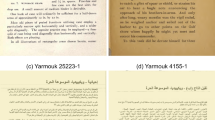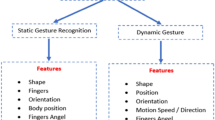Abstract
The Arabic Language has a very rich vocabulary. More than 200 million people speak this language as their native speaking, and over 1 billion people use it in several religion-related activities. In this paper a new technique is presented for recognizing printed Arabic characters. After a word is segmented, each character/word is entirely transformed into a feature vector. The features of printed Arabic characters include strokes and bays in various directions, endpoints, intersection points, loops, dots and zigzags. The word skeleton is decomposed into a number of links in orthographic order, and then it is transferred into a sequence of symbols using vector quantization. Single hidden Markov model has been used for recognizing the printed Arabic characters. Experimental results show that the high recognition rate depends on the number of states in each sample.
Similar content being viewed by others
References
Al-Badr B, Mohmoud S. Survey and bibliography of Arabic text recognition.Signal Processing, 1995, 4: 49–77.
Tolba M, Shaddad E. On the automatic recognition of printed Arabic characters. InProc. the Int. Conf. System, Man and Cybernetic, USA, 1990, Vol.4–7, pp.496–498.
Amin A, Alsadoun H. Hand printed Arabic character recognition system. InProc. the 12th Int. Conf. Pattern Recognition, 1994, Vol.2, pp.536–539.
Alherbish J, Ammar R. High-performance Arabic character recognition.The Journal of System and Software, 1998, 44: 53–71.
Amin A. OCR of Arabic character. InProc. the 4th Int. Conf. Pattern Recognition, 1988, pp.616–625.
Khella F. Analysis of hexagonally sampled images with application to Arabic cursive text recognition [Dissertation]. University of Bradford, England, 1992.
Al-Badr B, Haralick M A. Recognition without segmentation: Using mathematical morphology to recognize printed Arabic. InProc. the 13th National Computer Conference, Saudi Arabia, 1992, pp.813–829.
Makhoul J, Schwartz S. What is an HMM?IEEE Spectrum, 1997, pp.46–48.
Rabiner L, Juang B. An introduction to bidden Markov Models.IEEE ASSP Magazine, Jan., 1986, pp.4–16.
Rabiner L. A tutorial on Hidden Markov Models and selected applications in speech recognition. InProc. the IEEE, February, 1989, Vol.77, pp.257–286.
Bunke H, Roth M, Schukattalamazzini E. Off-line cursive handwriting recognition using Hidden Markov Models.Pattern Recognition, 1995, 28(9): 1399–1413.
Chen M, Kundu A, Zhou J. Off-line handwriting word recognition using an HMM type stochastic network.IEEE Trans. Pattern Analysis and Machine Intelligence, 1994, 16(5): 481–496.
Gray R M. Vector quantization.IEEE ASSP Magazine, 1989, 1: 4–29.
Author information
Authors and Affiliations
Corresponding author
Additional information
Abbas H. Hassin received the B.Sc. and M.Sc. degrees in computer science from Basrah University, Iraq in 1990 and 1995, respectively. From 1992–1995 he was a director of Database Information and Electronic Survey Division at College of Engineering in Basrah University. From 1995–2001 he was a lecturer at College of Science at the same university. Currently, he is a Ph.D. candidate in computer science at Harbin Institute of Technology (HIT), China. His research interests are Pattern Recognition and Character Recognition.
Xiang-Long Tang is the director of the T&R Division of pattern recognition and intelligent system at Harbin Institute of Technology, deputy director of Wearable Computer Engineering Center. He is a member of Council of Pattern Recognition and Machine Intelligence, Chinese Automation Society. His research field includes character recognition, image recognition, Chinese information processing, palm computer, biometrics computing. Prof. Tang has led 8 projects sponsored by the state, ministry/province and international cooperation. He has won a third prize of National Science and Technology Progress, a second prize, a third prize of Ministry level for Science and Technology Progress.
Jia-Feng Liu is an associate professor of Harbin Institute of Technology. He received B.S. and Ph.D. degrees from Harbin Institute of Technology (HIT) in 1990 and 1996 respectively. His research interests include pattern recogntiion, image processing and artificial intelligence.
Wei Zhao received her M.S. degree in pattern recognition and intelligence system from HIT in 2000. She worked on signature verification and word recognition in HIT from 1998. She is now a lecturer and a Ph.D. candidate at School of Computer Science and Technology, HIT. Her current research interests include pattern recognition, continuous character recognition and Chinese information process.
Rights and permissions
About this article
Cite this article
Hassin, A.H., Tang, XL., Liu, JF. et al. Printed Arabic character recognition using HMM. J. Compt. Sci. & Technol. 19, 538–543 (2004). https://doi.org/10.1007/BF02944755
Received:
Revised:
Issue Date:
DOI: https://doi.org/10.1007/BF02944755




